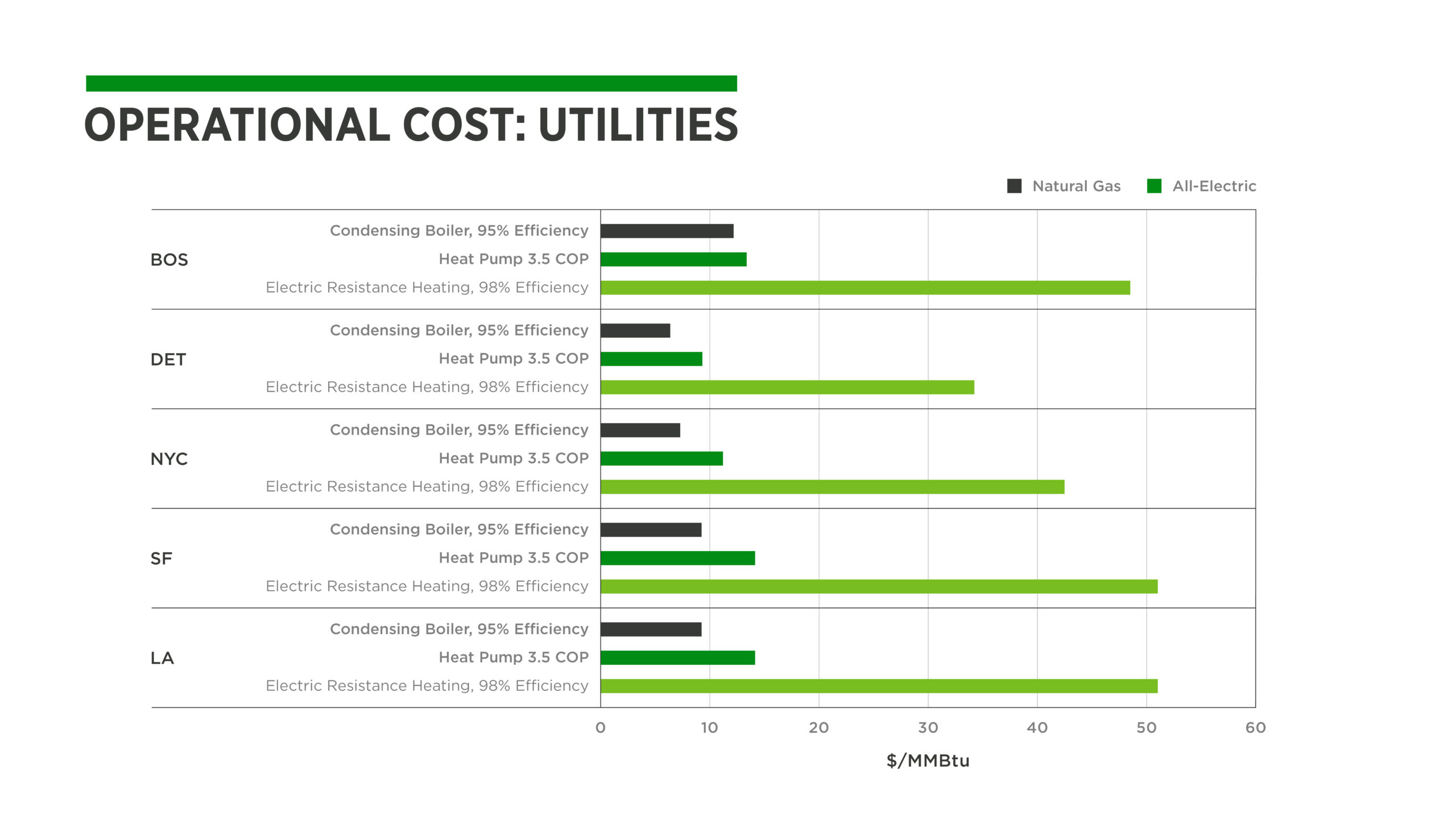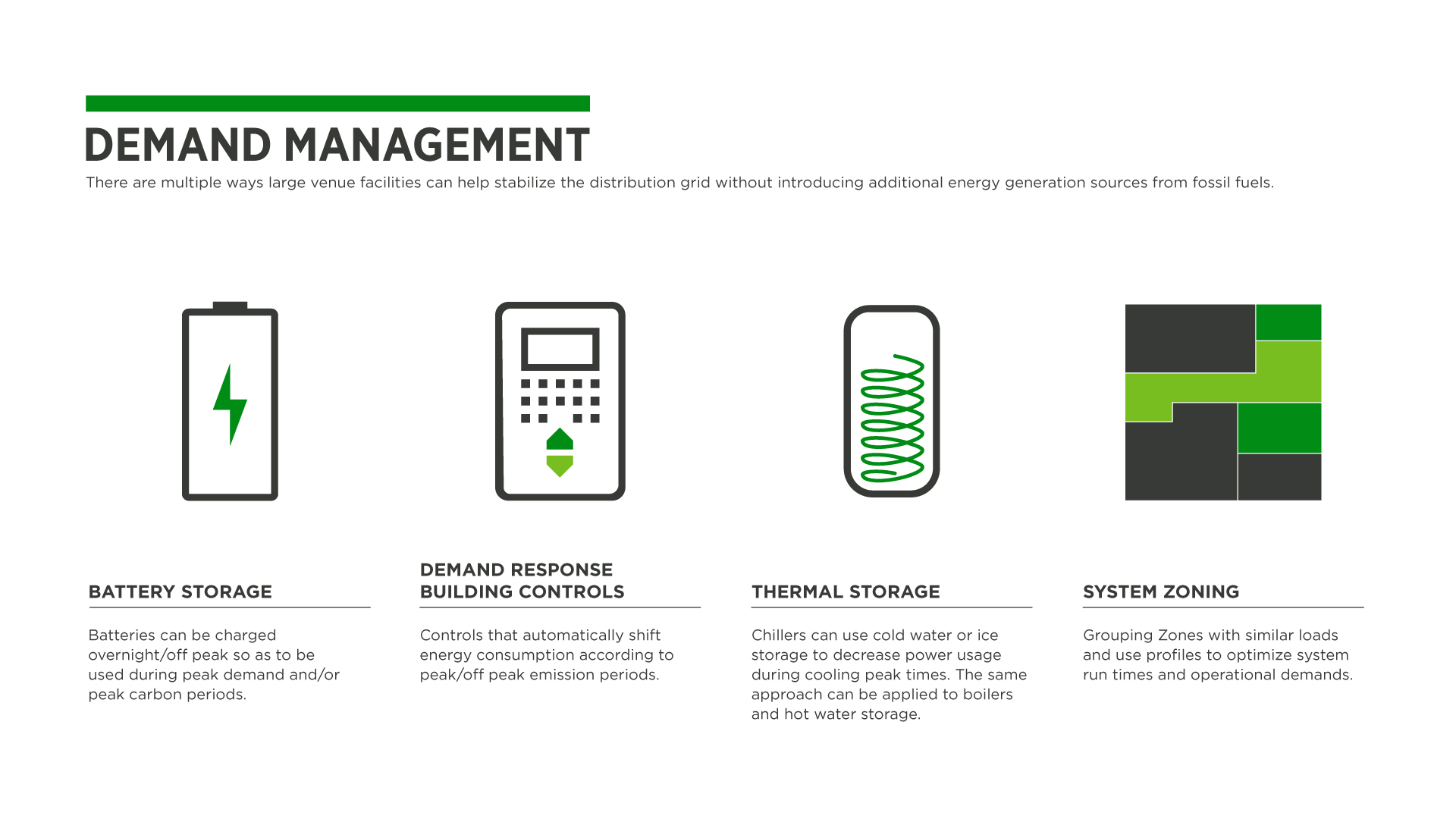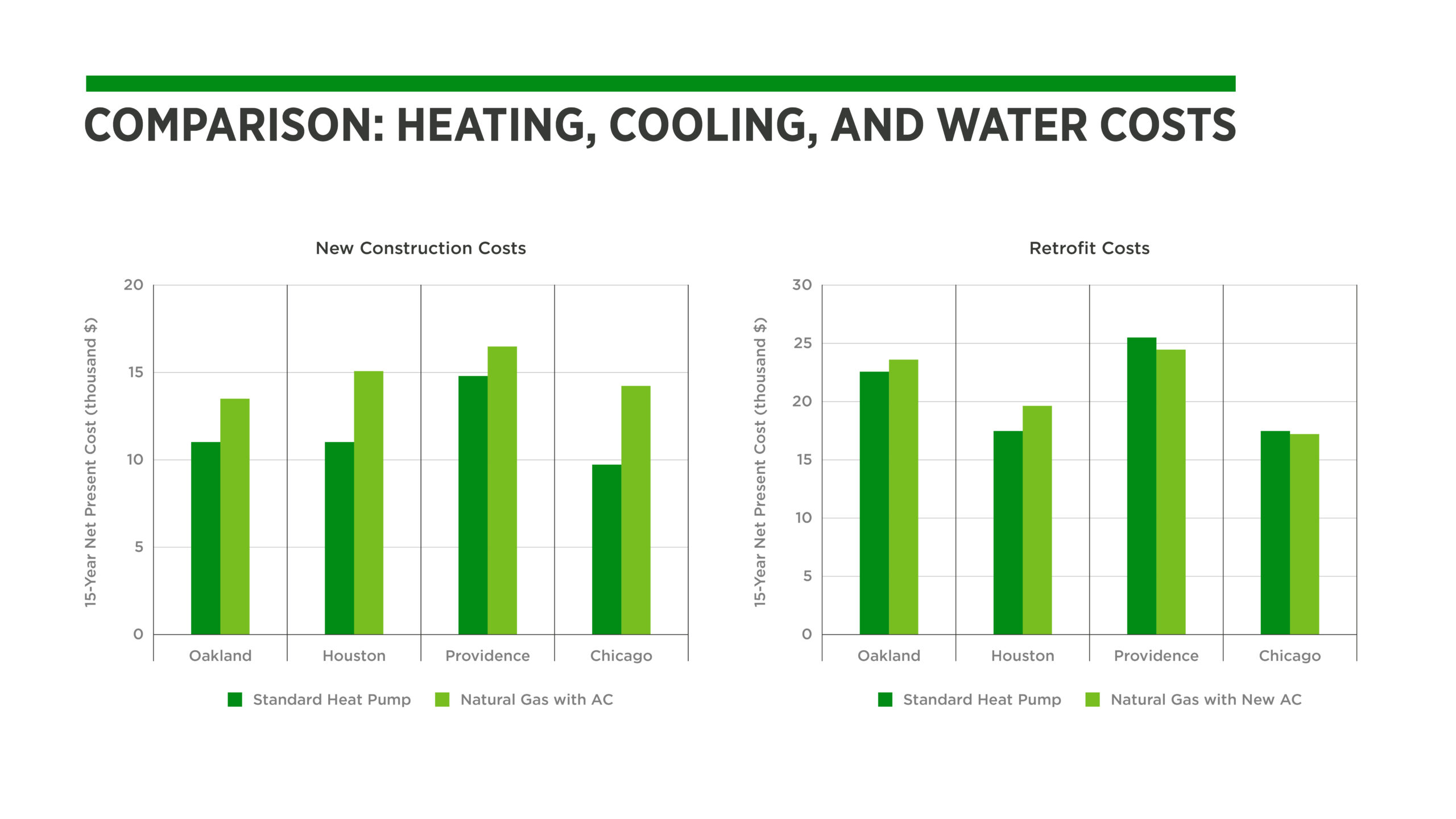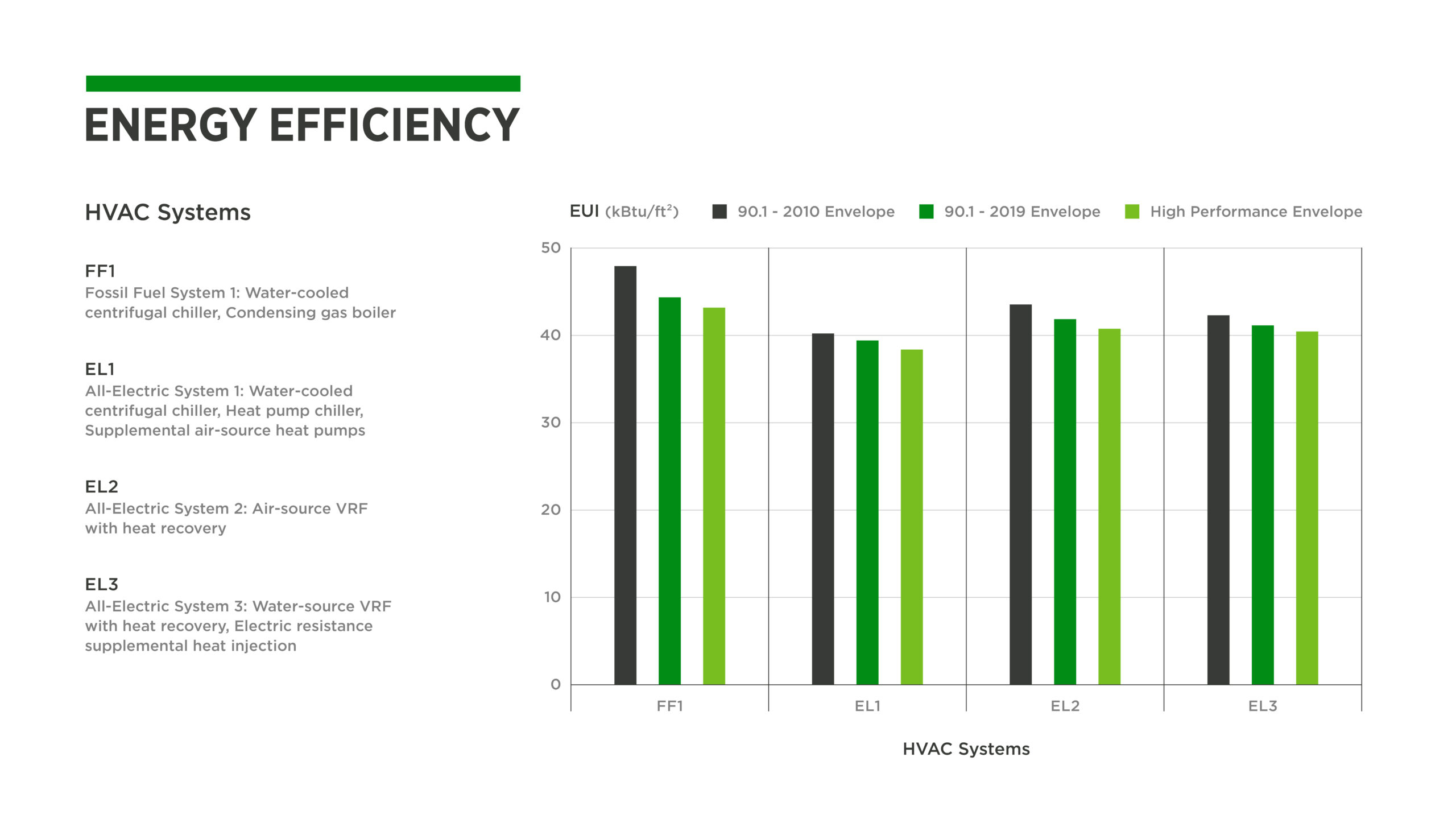Current trends indicate as we move forward with electric vehicles (EV), photovoltaics (PV) and high efficiency heat pumps (COP 2.5 and greater), the overall electrical energy consumed in the United States will rise more than 30%. However, given the forecasted gains in the overall efficiencies of our electrical infrastructure, that consumption will be reduced by more than 50%.
To achieve the forecasted gains, buildings of all shapes and sizes must be willing to invest in an all-electrical solution – especially buildings with large energy demands. This solution requires agreements and investments across all aspects of the electrical infrastructure from the utility plants and electrical grids down to the HVAC equipment within the smallest tenant improvement (TI) space. While this article could dig deeply into all the different facets of that process, what is most important is understanding the implications of electrifying buildings that cause the largest fluctuations of demand on the electrical grid.
Venue facilities are known power and energy hogs. However, most of these facilities are not used more than a few days a week or less, and sometimes only a few times during an entire year. The fluctuations on the grid caused by such facilities can have implications on other buildings utilizing the same utility service. To mitigate these fluctuations, a strategy called Load Shift needs to be utilized. Load Shifting consists of using multiple techniques, like Peak Shaving, to reduce the highs and lows of electrical consumption. By bringing these highs and lows on the grid to a plateau, the overall electrical system can become more stabilized. There are multiple ways to work with utility companies to help stabilize the distribution grid. However, what we are most concerned about in this article is what we can do within facilities themselves.
Grid Stabilization Approaches for Large Facilities
Traditionally, Load Shifting is achieved using co-generation or peak shaving diesel/natural gas generators. However, introducing additional energy generation sources from fossil fuels isn’t the solution. The key to achieving the stability we are looking for is to use existing technologies that have been improved by the ongoing push toward electrification. Thermal storage, battery storage and demand response building controls are just a few. When it comes to thermal storage, there is often program space that can be repurposed adjacent to central plants, main electrical gear and other energy intensive use equipment that can use that thermal storage capability. Chillers can use cold water or ice storage to decrease power usage during cooling peak times. The same can be said for the boilers and hot water storage. Thermal storage also has some other benefits that we will get into later. For now, though, the next technology that should be implemented is adding battery storage. Batteries and their inherent electrical storage capacity have far-ranging uses within venue facilities. Normally, batteries are used for emergency lighting, UPS systems or PV energy storage. Using batteries is often only discussed for these three applications because of perceived limitations and the general unwillingness to use batteries because of their high maintenance requirements. However, we can adopt using batteries in a similar way as thermal storage by charging them overnight/off peak so as to be used during peak times. With PV gaining even more traction and the desire to reduce overall greenhouse gas emissions, batteries have become a much more viable solution even compared to just three or four years ago. As with batteries, demand response controls have been used for years and are incorporated in multiple energy codes and recommended for energy efficient buildings.

As discussed earlier, thermal storage is a great way to not only have an energy efficient building, but to also improve grid stability while fully electrifying buildings. But there are other benefits of using thermal storage that are not as obvious, including the reduction of equipment. By sizing thermal storage to offset or even completely supply the cooling and heating for day-to-day operations of a venue facility, you remove the small-scale chillers and boilers that are typically needed. This in turn opens more space for energy efficient storage options and equipment.
While space is always at a premium regardless of building scope or size, it’s arguably even more crucial within venues whose highest priority is the fan experience. A fan experience, though, cannot be achieved by a building that is not planned appropriately for energy efficiency and HVAC comfort. It seems odd to think of building efficiency tied to patron comfort, but one does not have to be sacrificed for the other. By planning to use the facility to its full potential, the central plant, thermal storage and other energy efficient equipment can be used to power and condition the day-to-day operations of a sports team, or the adjacent offices, or even part of a university campus facility. Tying administration, office, and training buildings together with venue utility loops allows for an electrified central plant to be used year-round. This decreases electrical loads on adjacent buildings, relieving some of the added load to the grid from the overall electrification effort.

Taking these integrated approaches to the design, the project team can examine how to make the overall building better and more efficient. As discussed previously, this space could be devoted to thermal storage for heat/cold energy recovery or set up to hold more interactive building management system interfaces. Using the building management system interfaces, the building can be set up with adaptive temperature control schemes to adjust the supply/set point temperatures in the facility to decrease peak electrical demands. Another technology that can be implemented on the controls side to assist in the electrification of buildings is system zoning. This technique works with the adaptive temperature controls scheme and shifts heating/cooling load to the areas that need it most, helping to decrease demand on the HVAC and electrical systems.
Other ways to decrease the demand on the electrical systems are not traditionally part of the electrical engineer’s design. These include a more concentrated effort working with the architect and owner to identify where improvements to the building envelope can be made. Typically, this would include better insulation, glass, and general improvements to mitigate energy losses through the construction of the building. Now, more attention should be paid to using the building mass to store thermal energy. Much like a large concrete parking garage maintains temperature, a building as large as most venue projects can use that thermal mass to its advantage.

With all building energy solutions, regardless of the use of Load Shifting and electrification efforts, there is a large dependency on utilities and the resiliency of the distribution grid. The amount of energy consumed, whether electric or otherwise, requires a partnership between the utility and the venue. It is up to the design team and ownership group to make the efficiency and electrification goals clear at the onset of project design. Design teams need to explore what incentives are available from the utility for electrification and the utility needs to explore what governmental subsidies will be given to improve the grid to allow for the electrification. Along with the grid improvements, the utility will also see increased revenue due to the electrification effort. With that increase in revenue, the utility may be more willing to work out a more favorable rate and fee structure for the venue facility.
While not directly tied to building electrification, a venue can create other partnerships through branding, working with local trade schools and manufacturers of energy efficient equipment. By partnering with brands in the energy industry, venue facilities actively show how invested they are with being as efficient as they can be. Two drawbacks of being on the leading edge of electrification and energy efficiency is the lack of skilled labor and the limited number of manufacturers who can build the equipment needed. By working with trade schools, either via offering grants or scholarships, the venue facility and utility company can work together to further the goals of training for the future and going fully electric. Helping nurture future skilled laborers needed to further electrify additional buildings will then help incentivize additional manufacturers to reinvest or continue to invest in energy efficient electrical solutions.

Full Electrification is Worth Pursuing Despite Potential Drawbacks
What are the drawbacks for going for full building electrification if the technology is there? We have hinted at a few of these throughout the article, but the main two drawbacks are up-front costs and an unwillingness to change or try new things. While no facility, venue or otherwise, wants to be a guinea pig, venues could benefit more from electrification when compared to a small retail tenant, for instance. It is all about economy of scale; a retail tenant in a mall may only need 200 amps of power for full electrification whereas a venue facility may need 20,000 amps of power. This amount of electricity gives the venue much more flexibility to invest in more efficient sources of heating and cooling. It also gives the design team and ownership something – an opportunity to save money for the venue and the utility since less power demand from the venue means less infrastructure and grid improvements. However, the costs to invest in the more efficient electrical equipment must be recognized and discussed at the earliest concept design phases of a venue. It is imperative that all parties understand that electrification is achievable for an NBA arena, NFL stadium or even a smaller collegiate soccer and lacrosse facility. High efficiency electric boilers, heat pumps and electrical cooking equipment are the first pieces of equipment to investigate in an electrification study. Couple that equipment with point of use electric water heaters and in-duct electric heaters and the venue is almost fully electrified. The costs for these electrified, high efficiency solutions at first glance appear to be higher than having a natural gas equivalent solution. However, close examination proves otherwise. A great example is cooking equipment. Even the most progressive chef may balk at using anything but natural gas for cooking, but look at all the infrastructure (gas service, meter, pressure reduction equipment, potentially thousands of feet of piping, venting, etc.) that is required to have a char broiler or gas range when an electrified version is readily available. Now think of the savings in piping, flues, etc. for a natural gas central plant scenario. All the equipment needed for a central plant can be replaced with more efficient electrified versions. And if large enough equipment is hard to source for the boilers, point of use systems can be provided. The next hurdle to overcome is the shift from the current technology to the all-electric versions. Gas equipment has been used for multiple decades and almost any maintenance professional completely understands how that equipment functions, how it needs to be repaired and where the common points of failure are. The newer electrified equipment is perceived to be much more difficult to be maintained, repaired, or replaced. However, the systems are as easy to replace and maintain as their gas counterparts. The electrified equipment is also significantly smaller than its gas counterparts.
Electrification is possible for all building types right now. As electrification becomes the goal across multiple project types and sizes, but especially for venue sized projects, coordination of expectations and goals becomes the most important part of the design process. The key is for all parties to be on the same page regarding the technologies available now and the future goals of the facility. This gives owners and operators of venues the ability to remove an energy source from their buildings (natural gas), decreases the overall energy consumed and sets the facility up to achieve even more sustainability goals as the efficiencies of boilers, chillers and heat pumps continues to rise.
Venue facilities are known power and energy hogs despite their general limited usage. Building electrification provides an opportunity to deliver energy efficiency and is a key strategy to reduce and eliminate long-term operational CO2 emissions.
Join our email list to get the latest design innovations, technical content, new projects, and research from Henderson’s experts delivered straight to your inbox.